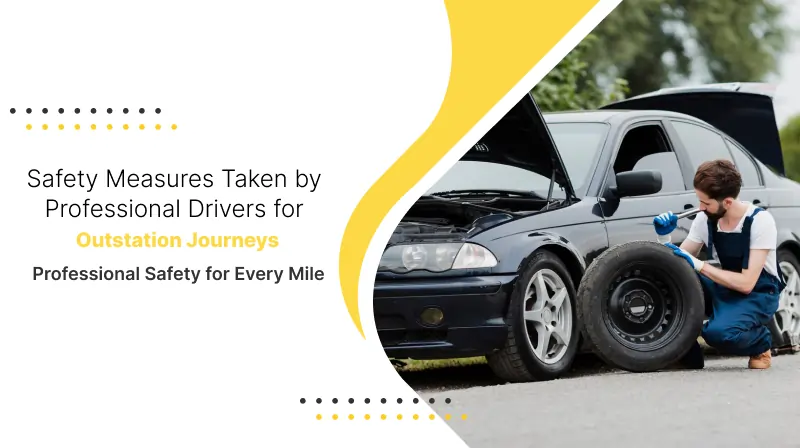Introduction
During long trips, safety is key. It makes the drive easy and stress-free for everyone in the car. Pro drivers care about safety. They stick to rules to make your journeys safe and fun. Let talks about safety measures taken by skilled drivers for outstation travels.
Why Safety Matters in Outstation Travel
Travel safety tops the list. For extensive trips, issues like weariness, poor paths, and car troubles are frequent. Skilled drivers are equipped to manage these hurdles. They adopt safety measures such as:
- Keeping passengers safe and comfortable.
- Prevent accidents by staying alert.
- Ensure the vehicle stays in good condition.
Professional drivers don't leave safety to chance. They plan and prepare for every trip.
Key Safety Measures Drivers Follow
Drivers who are pros put safety first on all trips. They stick to firm rules to provide a safe and seamless ride for passengers. Here are the key safety habits they follow:
Pre-Trip Vehicle Checks
Before starting any trip, professional drivers inspect their vehicles. This ensures the car is safe and ready for the road. They check:
- Brakes: To avoid sudden failures
- Tires: For proper pressure and grip.
- Lights: To ensure visibility, especially at night.
- Emergency Tools: : Such as spare tyres, first-aid kits, and fire extinguishers.
These checks help prevent issues during the journey.
Sticking to Speed Limits
They are serious about sticking to speed limits; they know going fast can cause an accident. Staying safe means not going too fast.
- Reduces the chance of accidents.
- Makes passengers feel more safe.
- Improves fuel efficiency.
Trained drivers focus on control, not speed.
Managing Fatigue
Long drives can be tiring. Tired drivers are more likely to make mistakes. Professional drivers take steps to avoid fatigue:
- They rest before starting a trip.
- They take breaks during the journey.
- They avoid driving late at night when they are less alert.
These habits keep drivers fresh and focused.
Defensive Driving
Expert drivers keep an eye on what's around them. They use tactics that keep them safe on the road, no matter what. This involves:
- Keeping a safe distance from other cars.
- Watching out for road hazards.
- Avoiding sudden lane changes or risky moves.
Defensive driving helps prevent accidents, even in harsh conditions.
Advanced Safety Protocols
Pro drivers go beyond simple safety rules. They employ sophisticated techniques for better protection. Their experience and use of tech make them unique in keeping safety at its best.
Training and Certification
Trained drivers know the rules of the road. They learn how to handle emergencies and tricky situations. Many professional drivers complete courses on:
- Road safety laws.
- Emergency response techniques.
Using Technology
Modern tools help drivers stay safe. GPS navigation helps them choose the best routes. Fatigue detection systems monitor their alertness during long trips. These tools make journeys smoother and safer.
Safety and Passenger Comfort Go Hand-in-Hand
A safe trip is also a comfortable one. Drivers focus on both. They make sure:
- The car is clean and hygienic.
- Passengers feel respected and at ease.
- The journey is smooth, even on rough roads.
When safety is a priority, passengers can relax and enjoy the ride.
Why Choose Professional Drivers for Long Trips
Professional drivers ensure safe, comfortable, and stress-free journeys with their expertise and reliability.
- Fewer Risks: Their experience helps prevent accidents.
- Comfort: They drive smoothly and responsibly.
- Efficiency: They know the best routes and how to avoid delays.
Professional drivers make every trip safer and stress-free.
Conclusion
Safety is the most essential part of any journey. Professional drivers follow strict measures to keep trips safe and enjoyable. From vehicle checks to defensive driving, they take care of everything. When you travel with trained drivers, you can sit back and relax. Choose professionals for your next outstation trip and enjoy a worry-free experience.
FAQ
Q.1: What safety measures do professional drivers follow on long trips?
Professional drivers follow strict protocols like pre-trip vehicle checks, adhering to speed limits, managing fatigue, and using defensive driving techniques.
Q.2: Why is fatigue management important for long-distance drivers?
Fatigue reduces alertness and increases accident risks. Drivers manage it by resting before trips, taking breaks, and avoiding overnight driving.
Q.3: How do professional drivers ensure passenger safety?
They perform vehicle inspections, follow speed limits, maintain hygiene, and use defensive driving practices to ensure a secure journey.
Q.4: Why should I hire professional drivers for outstation travel?
Professional drivers bring expertise, follow strict safety measures, and ensure a comfortable, risk-free, and efficient travel experience.
Q.5: What tools do drivers use for safer long trips?
Drivers use GPS for optimal routing and fatigue detection systems to monitor alertness, ensuring smoother and safer journeys.
Q.6: How do vehicle inspections improve travel safety?
Pre-trip checks of brakes, tyres, lights, and emergency tools prevent breakdowns, ensuring the car is road-ready and reducing risks during the journey.
